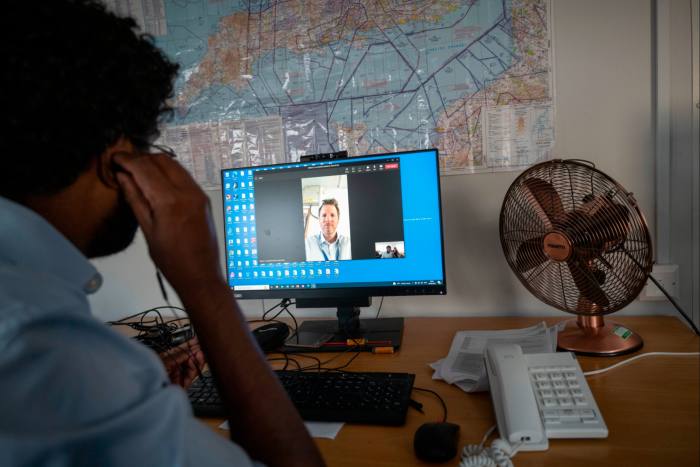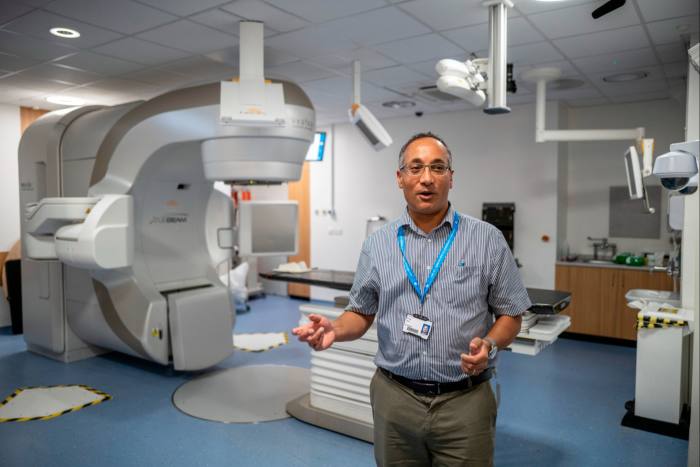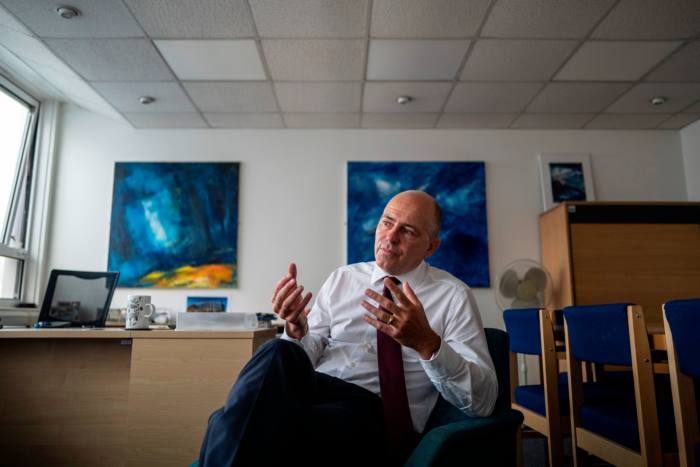In an operating theatre at Addenbrooke’s hospital in Cambridge, Andrew Myles is undergoing a prostatectomy. The procedure is relatively lengthy but thanks to pioneering robotic surgery the 59-year-old will require just a single night in a hospital bed.
Peering through a monitor, surgeon Arthur McPhee explains that the high-tech procedure allows him to make smaller and more precise cuts, which will allow Myles to be discharged the following day — four days sooner than traditional surgery would have permitted.
Back on the ward a few hours later, Myles tells a nurse he feels fine apart from a little pain in his tummy area, joking that he has endured “six stab wounds”.
Such new ways of working are helping Addenbrooke’s to treat more patients and use staff more effectively against the backdrop of a National Healths Service struggling with a record 7mn-long waiting list for hospital care, perilously overcrowded A&E departments and among the highest waits in Europe for cancer treatment.


In his Autumn Statement, chancellor Jeremy Hunt announced an additional £6.6bn for the NHS over the next two years, handing the NHS some largesse at a time of generally sharp spending restraint. But he also warned the health service: “We want Scandinavian quality alongside Singaporean efficiency, both better outcomes for citizens and better value for taxpayers.”
At Addenbrooke’s, the crisis in the health service has spurred changes. While some, like robotic surgery, involve technological advances, many of its interventions are surprisingly simple and low-cost. Most have called only for a more flexible mindset among staff and a willingness to overcome normally rigid divisions between different parts of the health and care system — raising hard questions as to why, in a famously centrally-directed health service, they have not been adopted everywhere.
Roland Sinker, chief executive of the Cambridge University Hospitals Trust which includes Addenbrooke’s and an M&A lawyer and strategy consultant before joining the NHS in 2005, divides the productivity challenge facing the service into two buckets: “how do we do more with what we’ve got” and “innovation”.
Both goals are on display at 7.15am on a recent morning at the Day Case and Overnight ward. The patients here all have sufficiently robust underlying health to be treated and discharged after just one night, despite the fact that some, like Myles, are having major surgery.
Graham Johnston, the operations manager, said he and his colleagues had “push[ed] the envelope” by redefining the notion of “generalist” surgical care to include some cases that previously required more specialised support.


In order to discharge complex patients so speedily, nurses have had to be “upskilled” to deal with a wider variety of conditions than they would normally encounter on a short-stay ward. This initiative has helped the hospital reduce its backlog of patients waiting more than two years from 170 a year ago, to just one today.
Elsewhere new partnerships have been forged between different parts of the health system. Frustrated by the laborious administrative process of securing referrals to specialists for patients, Dr Tim Wright, who works for a large local GP practice, and Addenbrooke’s neurologist Dr Nushan Gunawardana joined forces to introduce a system that allows GPs to connect directly with consultants via video link to discuss cases, frequently resolving concerns without the patient setting foot in the hospital.
According to Wright, data gathered since the pandemic had shown at least a 60 per cent reduction in letters sent by GPs to consultants seeking advice, and a 15 per cent reduction in hospital referrals.
Sinker said he believed “those sorts of developments are incredibly powerful and helpful, and it’s not ‘teaching hospital tells GPs what to do with neurology patients’. It’s hearing from GPs [about] what they’re dealing with, what’s presenting itself, how can we help them do more?”
A similar transformation has taken place in the endoscopy department. Concerned about how many suspected cancer sufferers were not receiving a diagnosis within the national target of 28 days, consultant gastroenterologist Dr Gareth Corbett devised a way to simplify the system.
Previously the department’s protocol required hospital doctors to review all results for patients after they were referred by a GP. Corbett’s idea was to reduce the role of consultants in that process, first by taking the diagnostic referral on trust, without the need for another layer of approval, and secondly by training nurses to look at the scans and biopsy results, the vast majority of which come back clear. Only when the nurses are concerned do they request a review of a result by a consultant.
The improvement was instant, said Corbett. From the first week of the new way of working being introduced, “the 28-day target was hit immediately for over 85 per cent of referrals”. He described the changes, which have caught the attention of national NHS leaders, as “really low-tech” but acknowledges that some consultants needed persuasion to change entrenched ways of working.


Not all the interventions are so simple. In the radiotherapy department, oncologist Dr Raj Jena explained that when a patient comes in for curative radiotherapy it can take up to two hours to mark up the tumour in order to ensure that the healthy tissues around it are shielded as far as possible from radiation.
He has worked with Microsoft to create an AI programme using data from patients previously treated in the department that “does much of the work in the background so that when the oncologist sits down to start this task, most of the heavy lifting is done”. It is “the first cloud-based AI medical device to actually be written from within the NHS, to be deployed across the NHS for free”, he said.
The impact on productivity is clear, he suggests. It has allowed him and his colleagues to “go about 13 times faster when preparing curative radiotherapy treatment”, removing one of the major obstacles to pushing patients through treatment faster and in greater numbers. “AI like this is the key to the workflow acceleration,” Jena said.
As the NHS faces the prospect of rising inflation cutting further into budgets, Sinker says he is applying the lessons of the pandemic: “protect frontline staff, give teams at the frontline the chance to innovate in a way that they want [by getting] out of their way, and reach out and find partners to help you do things.”
Stay connected with us on social media platform for instant update click here to join our Twitter, & Facebook
We are now on Telegram. Click here to join our channel (@TechiUpdate) and stay updated with the latest Technology headlines.
For all the latest Business News Click Here
For the latest news and updates, follow us on Google News.
